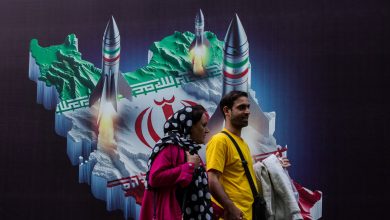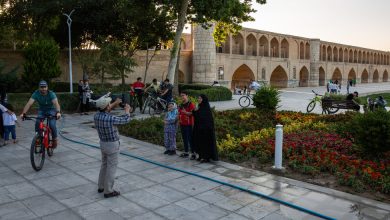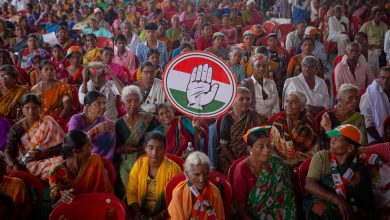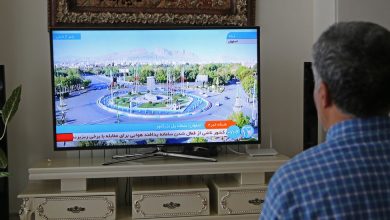‘Poor Kids’: Bodies of 2 Youths Found Near Syrian Prison Where 500 Died

HASAKA, Syria — The boy had dark brown hair coated in white dust, and on his chin were the wispy beginnings of a beard.
On Sunday, his body and that of another youth were found lying on a dirt road behind the prison in northeastern Syria where a Kurdish-led force, backed by the U.S. military, fought for more than a week to put down an attempt by Islamic State militants to free former fighters held there.
The discovery of the bodies was the first confirmation that at least two of up to 700 teenage boys, who had been detained in the prison because they were the children of ISIS fighters, were killed in the fighting.
The leader the Kurdish-led Syrian Democratic Forces, which ran the prison, acknowledged Monday that “a very small number” of the boys had been killed.
“Some escaped with the adults,” the commander, known by his nom de guerre Mazlum Kobani, said in an interview, his first since the siege began. “They were either rearrested or were killed.”
Some had been held as hostages during the prison siege, according to the S.D.F.
A fuller accounting of the ISIS prison siege, and the efforts by the Kurdish-led militia and American forces to put it down, emerged on Monday, a day after the Syrian Democratic Forces, or S.D.F., regained full control over the Sinaa prison in the city of Hasaka.
About 500 people were killed, 374 of them linked to ISIS, the S.D.F. said. The death toll also included about 40 S.D.F. fighters, 77 prison staff and guards, and four civilians.
The group also said that the ISIS fighters who assaulted the prison had used sleeper cells to aid in the attack, and that the prison assault was part of a larger plot to also attack the giant detention camps in the same region that hold tens of thousands of people, most of them wives and children of ISIS fighters, and the city of Raqqa, once the de facto capital of the Islamic State’s so-called caliphate.
The boys had been held at the prison in Hasaka for three years as the international community debated what to do with them.
The Aftermath of Syria’s Civil War
After a decade of fighting, many Syrians wonder if the country can be put back together.
- The ISIS Fight Isn’t Over: Attacks in Syria and Iraq make it clear that the Islamic State is re-emerging as a serious threat.
- A Landmark Trial: A German court convicted a former Syrian officer of crimes against humanity in a historic verdict for those seeking justice.
- The Toll of U.S. Airstrikes: Secret American forces repeatedly killed Syrian civilians and bombed a vitial dam on a “no-strike” list.
- Bashar al-Assad’s Tenuous Grip: Despite his apparent victory in the civil war, the Syrian president remains mired in crises.
- A Drug Empire Flourishes: Powerful associates of Mr. al-Assad are making and selling amphetamines, turning Syria into a new narcostate.
The S.D.F. has said that their ties to the Islamic State made them dangerous, and some of the older ones may have been trained to fight, while human rights organizations consider them victims, children brought to the Islamic State through no choice of their own.
Both groups have clamored for the boys’ home countries to repatriate them.
Mr. Kobani, the S.D.F. commander, said he had been asking the international community for three years to build rehabilitation centers in his impoverished region. Without better facilities or unless their countries taking them back, he said, there was no where else but the prison to put them.
The bodies of the two boys seen by The New York Times on Sunday lay on a dirt road along with the remains of four other corpses, all of them dismembered. All appeared to have been shot.
One of them still wore socks made from gray blankets used at the prison. Fragments of orange prison uniforms were strewn nearby.
Some of the neighborhood boys kicked the corpses as they passed by, in a display of the deep hatred that many residents of this area harbor toward ISIS.
Neighborhood residents said the boys were among a group of escaped inmates, most of them Iraqi, who were killed on Friday by the S.D.F. as its troops went door to door to hunt down ISIS fighters.
“Poor kids, they turned them into soldiers,” said a neighbor who did not give her name out of fear for her safety. “We wish they would take them away.”
It was not clear whether the boys had sought to escape with the ISIS fighters or were still being held hostage by them. Several residents said they did not see the boys or the escaped inmates alive and did not know whether any had been armed.
Mr. Kobani said that all of the boys were trained ISIS fighters, an assertion disputed by human rights groups. And he said the boys ranged in age from 15 to 17. Other S.D.F. officials have said the boys were as young as 12.
He also appeared to be shocked about a Times report on Sunday that at least 80 bodies were dumped from a front-end loader onto the street and then shoveled into a gravel truck to be taken away to a mass grave.
“This is my first time hearing about it,” Mr. Kobani said. “If this happened, it is a sin.”
The American-led military coalition in northeast Syria, asked about the dead boys and the bodies being dumped, called both “an unfortunate reality” in war.
“The S.D.F. employed the appropriate amount of lethal force to counter the attack and quell the detainee uprising,” the coalition said in a statement. “Time and again they tried to negotiate a full surrender, and used the necessary force to respond to hostile actions.”
“Although the images The New York Times witnessed are disturbing,” the statement added, “they are an unfortunate reality in armed conflict where there are significant casualties and measures must be taken to limit the spread of disease.”
The streets around the prison were littered with the rubble of homes destroyed by security forces who used armored bulldozers and fighting vehicles to kill ISIS fighters and escaped prisoners who refused to surrender. Residents said they saw armored vehicles flying American flags taking part in the operations.
The prison attack drew in U.S. forces and turned into the biggest battle between the American military and ISIS in the three years since the group lost the last remnant of its so-called caliphate, a large swath of territory in Syria and Iraq. The United States conducted airstrikes and provided intelligence and ground troops in Bradley fighting vehicles to support the S.D.F. efforts.
Abu Jassim, another resident who lived in the neighborhood behind the prison, said he returned to his house on Friday and found four escaped inmates there wearing their prison uniforms.
“They said ‘Come in and sit down. Do you know us?’” he recounted. “I said ‘You are the Islamic State’. They said ‘Sit down and don’t interfere.’”
Two of the escaped prisoners were from Iraq while another was from Chechnya, Abu Jassim said. They told him not to be afraid and that they would leave when it got dark. He persuaded them to let him leave the house.
He reported their presence to the S.D.F., which arrived soon after with bulldozers.
“They started to hit the walls until the house fell down,” he said.
Their four bodies were those later seen on the street near those of the two boys.
The S.D.F. said that based on seized ISIS documents and the confessions of captured ISIS leaders, it had determined that the prison attack was part of a much larger plan. If it had succeeded, the S.D.F. said, the group would have attacked surrounding neighborhoods, Raqqa, and the sprawling Al Hol detention camp that holds an estimated 60,000 family members of ISIS fighters.
Al Hol, about 40 miles from Hasaka, is the main detention camp set up to house the families of ISIS fighters detained after the fall of the caliphate three years ago.
S.D.F. factions secure both the exterior and inside of the camp but do not have enough guards to be able to combat increasing ISIS activity there, including frequent murders. Mr. Kobani said that he has asked for more U.S. and coalition support to secure al-Hol and other detention camps and prisons.
Both the camp and the prison lie in an isolated and impoverished breakaway region in northeastern Syria. The S.D.F. has struggled to maintain control over both and has long warned that it cannot safely guard them.
Among the camp residents are several thousand foreign women and children whose home countries have refused to allow them to come back. They live in unsanitary conditions and children have died there of malnutrition and lack of medical care.
One resident living near the prison, a Syrian government employee named Hassoun, said that groups of armed ISIS fighters had forced their way into his home Friday morning and again that night.
Hassoun, who asked to be identified by his first name only out of fears for his safety, said that the gunmen took his phone, flipping through it to see if he was a member of the security forces. All of the militants were Iraqi, he said.
“They were complaining about the internet — they said ‘the Syrian internet is slow’,” Hassoun said.
At one point, he said, one of the gunmen opened the door to check the street and said, “There is an infidel dead.”
It was one of Hassoun’s neighbors, shot by ISIS fighters after they found a photo of him in an S.D.F. uniform during compulsory military service. Relatives identified him as Ghassan Awaf al-Anezi, 20.
“It was horrifying,” Hassoun said. “I was just praying for the sun to rise.”



